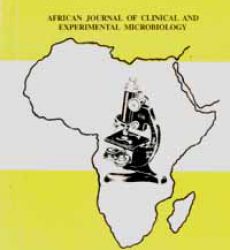*1Usman, S. O., 2Busari, I. I., 3Fagbemi, S., 2Adeniyi, M. M., 2Irabor, P., 4Usman, I. N.,
and 5Akintayo-Usman, N. O.
1APIN Public Health Initiatives, Akure, Ondo State, Nigeria
2Infectious Disease Hospital, Akure, Ondo State, Nigeria
3Ondo State Ministry of Health, Akure, Ondo State, Nigeria
4Department of Public Health, Ladoke Akintola University of Technology, Ogbomoso, Oyo State, Nigeria
5Nurse Tutors Programme, University College Hospital, Ibadan, Oyo State, Nigeria
*Correspondence to: senatorhopsy@yahoo.com
Abstract:
Background: The severe acute respiratory syndrome coronavirus-2 (SARS-CoV-2) is a novel strain of coronavirus, which is the cause of the current coronavirus disease 2019 (COVID-19) pandemic, ravaging many countries of the world. The objective of this study is to assess the symptomatology and case management outcome of hospitalized COVID-19 patients in Ondo State, Southwestern Nigeria.
Methodology: This was a longitudinal study carried out on randomly selected patients with COVID-19, confirmed by real-time reverse transcriptase-polymerase chain reaction (rRT-PCR), admitted to the Infectious Disease Hospital, Akure, from March to July 2020. Clinical and outcome data obtained from the patients were analysed using the Statistical Package for the Social Sciences (SPSS) version 24.0 software, and variables were compared using the Chi square (χ²) test and Odds ratio (OR).
Results: A total of 215 hospitalized COVID-19 patients were randomly recruited, with 103 males and 112 females (M:F ratio of 1:1.1), and mean age of 37.24 ± 16.83 years. The most common symptoms were shortness of breath (22.8%), cough (18.6%), fatigue (17.2%), runny nose (16.7%), fever (16.3%), and sneezing (14.0%). Mortality rate among the patients was 4.7% (10/215). Statistical analysis showed that fever [χ² = 8.75, OR 2.17 (95% CI: 0.29-16.63), p=0.003] and sneezing [χ²=11.35, OR 2.75 (95% CI: 0.34-18.27), p=0.001] were clinical presentations with significant impact on the final outcome of the patients.
Conclusion: This study showed that the most common symptoms in hospitalized COVID-19 patients were shortness of breath, cough, running nose, fever and sneezing, which underscores the importance of monitoring of patients for these symptoms.
Keywords: COVID-19, symptoms, management, hospitalized, outcome, Nigeria
Received Mar 8, 2021; Revised Apr 24, 2021; Accepted Apr 26, 2021
Copyright 2021 AJCEM Open Access. This article is licensed and distributed under the terms of the Creative Commons Attrition 4.0 International License <a rel=”license” href=”http://creativecommons.org/licenses/by/4.0/”, which permits unrestricted use, distribution and reproduction in any medium, provided credit is given to the original author(s) and the source.
Editor-in-Chief: Prof. S. S. Taiwo
Symptômes cliniques et résultats chez les patients hospitalisés COVID-19 dans l’État d’Ondo, dans le sud-ouest du Nigéria
*1Usman, S. O., 2Busari, I. I., 3Fagbemi, S., 2Adeniyi, M. M., 2Irabor, P., 4Usman, I. N., et 5Akintayo-Usman, N. O.
1Initiatives de santé publique 1APIN, Akure, État d’Ondo, Nigéria
2Hôpital des maladies infectieuses, Akure, État d’Ondo, Nigéria
3Ministère de la Santé de l’État de Ando, Akure, État d’Ondo, Nigéria
4Département de la santé publique, Université de technologie Ladoke Akintola, Ogbomoso, État d’Oyo, Nigéria
5Programme d’infirmières tuteurs, Hôpital universitaire, Ibadan, État d’Oyo, Nigéria
*Correspondance à: senatorhopsy@yahoo.com
Abstrait:
Contexte: Le coronavirus-2 du syndrome respiratoire aigu sévère (SRAS-CoV-2) est une nouvelle souche de coronavirus, qui est à l’origine de la pandémie actuelle de coronavirus 2019 (COVID-19), ravageant de nombreux pays du monde. L’objectif de cette étude est d’évaluer les résultats de la symptomatologie et de la prise en charge des cas de patients hospitalisés COVID-19 dans l’État d’Ondo, dans le sud-ouest du Nigéria.
Méthodologie: Il s’agissait d’une étude longitudinale réalisée sur des patients sélectionnés au hasard atteints de COVID-19, confirmée par réaction en chaîne par transcriptase-polymérase inverse en temps réel (rRT-PCR), admis à l’hôpital des maladies infectieuses d’Akure de mars à juillet 2020. Les données cliniques et les résultats obtenus des patients ont été analysés à l’aide du logiciel Statistical Package for the Social Sciences (SPSS) version 24.0, et les variables ont été comparées à l’aide du test du Chi carré (χ²) et du rapport de cotes (OR). Continue reading “Clinical symptoms and outcomes among hospitalized COVID-19 patients in Ondo State, Southwestern Nigeria”

